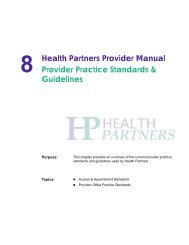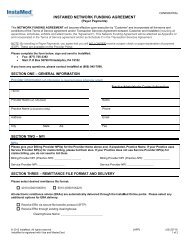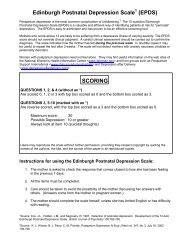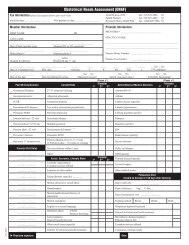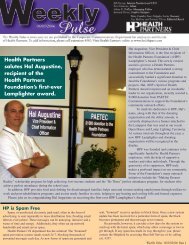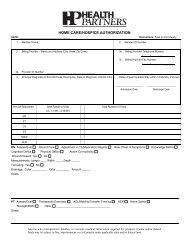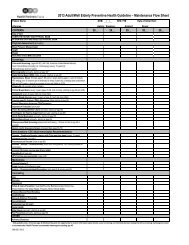PHYSICIAN CERTIFICATION STATEMENT (PCS ... - Health Partners
PHYSICIAN CERTIFICATION STATEMENT (PCS ... - Health Partners
PHYSICIAN CERTIFICATION STATEMENT (PCS ... - Health Partners
Create successful ePaper yourself
Turn your PDF publications into a flip-book with our unique Google optimized e-Paper software.
BACKGROUNDEffective February 24, 1999, Centers for Medicareand Medicaid Services (CMS) requires in 42 CFR Part410.40(d) a Physician Certification Statement (<strong>PCS</strong>)from the patient’s attending physician for nonemergencyambulance transportation. This form hasbeen designed to assist the healthcare professional todetermine if Medical Necessity has been met. Pleasecomplete all sections of this form and have anappropriate healthcare provider (as noted below) signwhere indicated attesting to the Medical Necessity ofambulance transportation services.WHO MAY SIGN THE <strong>PCS</strong>This <strong>PCS</strong> should be signed by the patient’s attendingphysician (or physician ordering transport). If unableto obtain the signature of the physician, this form maybe signed by a member of the physician’s medicalsupport staff. Medical support staff is defined as:physician’s assistant, nurse practitioner, clinical nursespecialist, registered nurse, or discharge planner whois employed by the hospital or facility where thepatient is being treated, with knowledge of thepatient's condition at the time the transport wasordered or services were furnished.DEFINITIONSMedical Necessity: <strong>Health</strong> <strong>Partners</strong> covers ambulanceservices if they are furnished to a member whosemedical condition is such that other means oftransportation would be contraindicated, irrespective ifsuch other transportation is actually available. Inaddition, for non-emergency ambulancetransportation, the definition of bed-confined (seebelow) must be met to ensure that ambulancetransportation is medically necessary.Emergency: Services provided after the sudden onset of amedical condition manifesting itself by acute symptoms ofsufficient severity (including severe pain) such that theabsence of immediate medical attention could reasonablybe expected to result in any of the following:i. Placing the patient’s health in serious jeopardy;ii. Serious impairment to bodily functions; oriii. Serious dysfunction of any bodily organ or part.Non-Emergency: Services provided to a patient whosecondition does not meet the above definition foremergency are considered non-emergency. In addition, allscheduled transports, and all transports to a non-acutehealthcare facility, would be considered non-emergency.Scheduled: Services that have been prior arranged 24 ormore hours in advance of the transport.REQUIREMENTS FOR <strong>PCS</strong>For non-emergency ambulance transportation servicesprovided to <strong>Health</strong> <strong>Partners</strong> members, the Code of FederalRegulations (CFR) 410.40(d)(2) requires ambulanceproviders to obtain a written order from the member’sattending physician, certifying that the medical necessityrequirements (listed above) are met, under the followingcircumstance:Scheduled: For scheduled ambulance transportationservices, the physician’s order must be obtained BEFOREthe provision of services and must be dated no earlier than60 days before transport. A separate <strong>PCS</strong> is required foreach transport except in the case of multiple scheduledtransports for the same diagnosis, e.g. dialysis, radiationtherapy, chemotherapy, etc. In these cases, the physiciancertificate will be valid for 60 days from the date it issigned.Bed-Confined: All three must be met before a patientis bed-confined, however bed confinement is not thesole determinant of medical necessity.i. The patient is unable to get up from bed withoutassistance; andii. The patient is unable to ambulate; andiii. The patient is unable to sit in a chair, or awheelchair.01.2012







